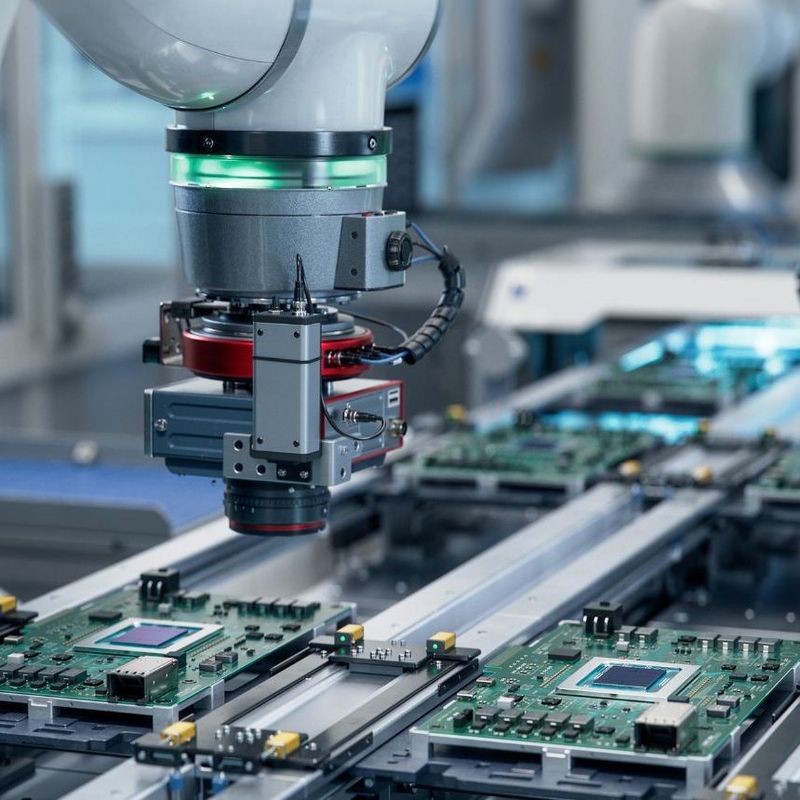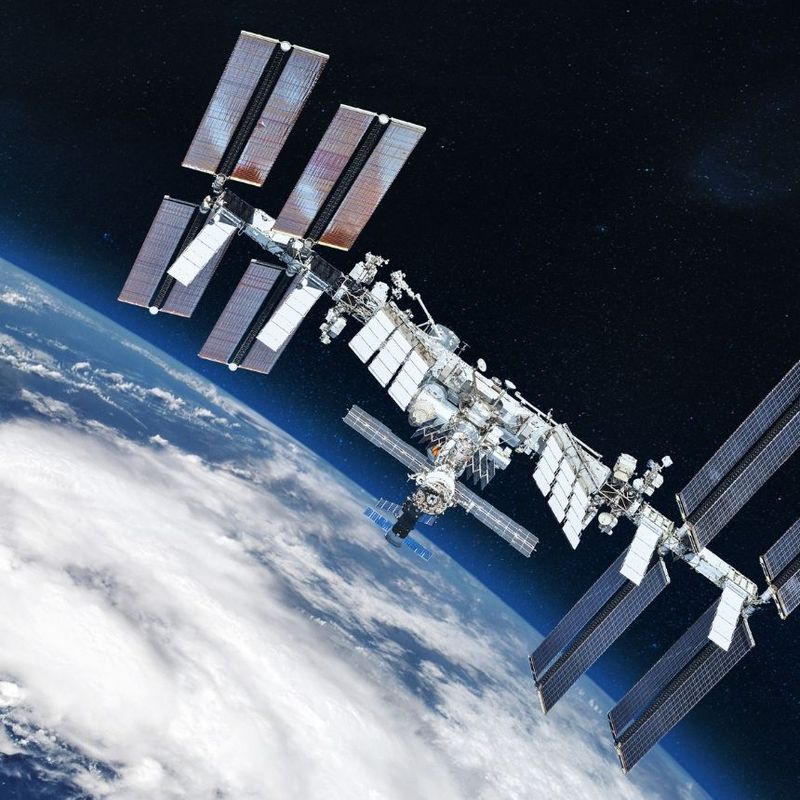30 April 2025
The International Space Station (ISS) has now been in continuous operation for 25 years. But, as NASA announced in mid-2024, its career will come to an end in early 2031, when the space station will be brought down to Earth in a controlled manner. But which experiments have the changing crews carried out in orbit, what developments have been hastened – and what plans are there to build new space stations in the near future?
At an altitude of 400 kilometres, the “most valuable and at the same time most unlikely machine” that the human race has ever built, as Alexander Gerst once called the International Space Station, ISS, orbits the Earth once every 90 minutes. The ESA astronaut spent a total of almost a year on the space station during his two missions – as one of over 250 individuals from 19 countries.
The fact that this could happen at all was due to the thaw in political relations at the end of the 1990s. The Iron Curtain had fallen, and the time seemed ripe for humanity to establish a shared outpost in space: In 1998, the USA, Russia, Canada, Japan and the European Space Agency ESA, which had eleven member countries at the time, signed a declaration of their intent to build the ISS.
In November 2000, astronauts moved into the space station permanently for the first time. Since then, it has grown module by module and now consists of six research laboratories, two residential units, an observation dome, various storage spaces and connecting nodes. With its solar panels, it is the size of a football field and, at 1,200 cubic metres, offers its occupants more space than an aircraft for 500 passengers.
Fully automatic space freighters
The crews were supplied with supplies via ESA’s Automated Transfer Vehicle (ATV), among other means. Between 2008 and 2015, each ATV carried over six tons of fuel, water, oxygen, food and equipment to the ISS.
The fact that all five flights went smoothly and according to plan is in part down to ALTER. The TÜV NORD GROUP subsidiary was entrusted by ESA with the procurement of a total of 2.5 million electronic components for the ATV (see box). And the experts tested these components in their laboratories to see whether they would be able to withstand the extreme conditions in space.
Closing terrestrial research gaps
But why go to all this enormous technical, logistical and financial trouble? Well, a scientific outpost in space offers several advantages: First of all, it allows us to have a different view of the Earth. For example, instruments are installed on the ISS that collect data on climate change. And it is also the ideal setting to test components for satellites. One such example would be the prototype of a high-resolution camera for mini-satellites, which the experts at ALTER had also tested for suitability for use in space before it was installed on the ISS. And on the space station, experiments can be performed that would not be possible on Earth.
Highly complex supply deliveries for the ISS
Automated Transfer Vehicles were launched on missions to the ISS on five occasions between March 2008 and February 2015. Commissioned by ESA, built in Bremen and equipped with a highly developed navigation system, the supply freighters were able to automatically calculate their course for the rendezvous manoeuvre with the ISS and dock independently. Once in position, the ATVs and their engines were also used for routine orbit correction – to push the ISS, whose orbit decays by 100 metres every day, back up to its intended path. Since their lights were not on around the clock and they were not connected to the ISS’s noisy air conditioning system, they were also used by the crew of the ISS as a place to sleep. After a maximum docking period of six months, the ATVs were then loaded with waste and directed into the atmosphere, where they largely burned up. As orbital waste disposal units, they thus ensured that the crews of the ISS did not suffocate in their own waste.
One such experiment concerns the development of new alloys, i.e. metal mixtures, for instance. Alloys of aluminium and lead, for example, theoretically offer great potential for the construction of car engines and electrical contacts which would wear less than their present-day counterparts. Unfortunately, aluminium and lead never mix on Earth: If you melt them, the latter sinks to the bottom, while the former rises to the top. In the microgravity of the ISS, however, these and other alloys can be researched and new materials developed – such as particularly lightweight and resistant alloys for aircraft turbine blades that will reduce kerosene consumption and, consequently, CO2 emissions.
Ultracold atoms and simulated osteoporosis
In NASA’s Cold Atoms Lab, American and German scientists are researching ultracold atoms. “The ISS experiments make it possible to test quantum physics and our physical view of the world with an accuracy that can’t be achieved on Earth,” explains Volker Schmid from the German Aerospace Centre (DLR). The results of the investigations could also contribute to the development of more precise timekeeping methods or quantum computers.
Last but not least, the ISS will investigate how the human body reacts to weightlessness and other exceptional situations in space. This will be important for future long-term missions to Mars. And also for our life on Earth: The study of bone loss suffered by astronauts in weightlessness may rekindle efforts to treat osteoporosis on Earth. According to DLR, basic medical research on the ISS has already yielded new approaches to the treatment of common diseases such as high blood pressure or balance disorders.
© ALTER TECHNOLOGYALTER TECHNOLOGY was entrusted with the procurement of a total of 2.5 million electronic components for the Automated Transfer Vehicles (ATVs). These supplied the ISS crews with supplies.
© Adobe StockLike science fiction: a view of the well-designed interior of a state-of-the-art space station.
Transition to the commercial age
Companies are also increasingly testing their technical developments on the ISS. ESA has now docked an external platform for commercial experiments to its Columbus research module, whose components were also pre-tested by ALTER. And NASA does indeed see the future of commercial research as being in orbit. Post-ISS, it no longer intends to operate its own station in Earth orbit, but instead to rent space stations from private companies. The first of these is the US company Axiom Space, which has been commissioned by NASA to develop a new module for the ISS. The first of these modules is scheduled to dock in 2026, with others to follow. When the ISS ceases to operate, these modules will be separated from it and joined together to form an independent space station.
Axiom Space is by no means the only company making plans for space stations. US company Vast also plans to launch its Haven-1 station into orbit in 2026. From that point on, four paying customers at any one time will be able to spend up to 30 days on the ten-metre-long space station. For the following years, Vast plans a larger station and is applying for funding from NASA’s programme for commercial space stations. The company has already funded a joint venture between Sierra Space and Jeff Bezos’ space company Blue Origin by contributing 172 million dollars through this programme. Its Orbital Reef space station, seen by the company as a “mixed-use commercial area in space”, successfully passed a number of important tests in 2024 and is expected to be ready for occupancy by 2027.
Lunar Gateway – the gateway to the moon
However, the age of state-controlled space stations is not over: China has been operating its Tiangong station since 2021. Russia aims to start building its own space station in 2027, to be followed by India in 2028. Modest in size compared to the ISS football field, their length is more likely to be measured in tennis courts.
NASA has no desire to operate its own orbiting space stations in the future. But 384,000 kilometres away from Earth, the situation is different: In collaboration with the previous ISS partner countries – excluding Russia – the US space agency is planning the Lunar Gateway. As part of the Artemis moon landing programme, this space station in lunar orbit is intended to serve both for research purposes and as a “transfer station” between the space shuttle and the lunar surface.
The first component is scheduled to blast off for the moon in 2027, followed by the first crew in module number 2 in 2028: The Lunar I-Hab is being built by ESA, with Japan’s JAXA contributing the batteries and life support systems. Measuring ten cubic metres, it will offer four lunar travellers as much space to live, sleep, eat and exercise as a family-friendly motorhome and enough resources to circle the moon for 90 days.
Legacy of the ISS
So even though the lunar station is much smaller and not designed for a permanent crew, it is “no exaggeration to say that Gateway is part of the legacy of the ISS,” said Stephanie Dudley, a project officer at NASA.
The latter will go on its year-long farewell tour around the world in 2030 before being sunk in a remote region in the South Pacific at the beginning of 2031. In the “graveyard of spaceships”, where, in addition to space capsules and the Russian space station Mir, the remains of the European Automated Transfer Vehicles, which reliably supplied the most unlikely machine in the world with supplies for years, have been laid to eternal rest.





